The clarinet is used across a wide range of musical styles from classical to rock. There are a few types of clarinets available, find out about them here.
Around the late 17th century, Johann Denner invented the first clarinet. Inspired by an instrument called a chalumeau, Denner crafted the clarinet we recognize today.
Since then, clarinets have gone through a number of changes and styles. Certain types of clarinets have become obsolete over time as the preferences of musicians and composers change.
This woodwind instrument appears in chamber music, classical, band, and even jazz. The complete range of a clarinet is the widest of any woodwind instrument. This makes it a valuable addition to any ensemble.
Did you know there are many types of clarinets available today?
The clarinet is a flexible instrument that plays a major part in a number of classical pieces. Its unique sound makes it a great instrument to listen to for music therapy, as well.
If you're curious about the different types of clarinets, read on to discover more.
Commonly Used Clarinets
These are the widely-used types in the clarinet instrument family today. These clarinets are the most functional and used in a variety of musical styles including classical and jazz.B-flat and A clarinets are currently the most popular due to their flexibility and sound. These are likely the two types with which you are most familiar. They both made of two constituent parts, the upper joint and lower joint
These are the clarinet types that you will most commonly see used in the most popular clarinet works.
1. B-Flat Clarinet

This is the most commonly used clarinet sometimes known as harmony clarinets. Used in different types of music from classical to concert band, this type is what most people picture when they hear a clarinet. Bb clarinet is one of the best choices for beginners and young clarinet players.
This Clarinet is a grenadilla wood model featuring silver plating and a cylindrical bore with high quality design that makes it easy to keep in tune.
Also recognized as one of the soprano clarinets, it was used often in jazz and swing. Popular clarinetists that used a B-flat clarinet include American jazz artists like Woody Herman.
2. A Clarinet
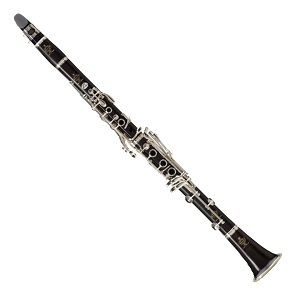
Another soprano clarinet, this type of woodwind instrument is also commonly used. This transposition instrument is a bit larger than the B-Flat clarinet.
Some clarinetists claim that the A clarinet has a more delicate sound, but the difference is very slight. This clarinet is suitable for a more advanced player or professional player. It has a rich sound and is usually played in orchestras and chamber music.
The A clarinet, or soprano clarinet in A, is an A transposing instrument. It’s the only common clarinet that is not in Bb or Eb and it’s slightly larger than the Bb clarinet but can be used in certain classical music situations as an alternative to the Bb clarinet. It has a slightly different timbre.
3. E-Flat Clarinet

This is a small clarinet that has a higher pitch, sometimes even shrill. While used in some pieces that need a bright sound, this instrument appears more in college-level or higher ensembles.
Also called sopranino in Eb Clarinet, this type of clarinet often assists the piccolo. It is not an easy variation to play and often requires re-tuning.
4. Alto Clarinet
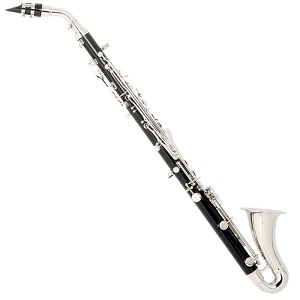
Much larger in size, this type of transposing clarinet has a low pitch and a distinctive bend shape. The alto clarinet is similar in pitch and appearance to the basset horn.
While used in concert bands or symphonic bands, the alto clarinet is rarely used in an orchestra. It doesn't project as much as a bass clarinet although it works well in clarinet choirs.
5. Bass Clarinet

This particular type of clarinet was popular with composers like Wagner. Its rich sound plays a key part in a variety of musical pieces from orchestral to concert bands and jazz.
The bass clarinet is much larger than some other types, and also has a distinct bend in the barrel. The large size and weight make this an instrument that requires a strap to play.
6. Contrabass and Contra-Alto Clarinets

Contrabass and contra-alto clarinets are one of the largest clarinet types in the family. A contrabass clarinet has several bends in its shape and can measure over seven and a half feet.
The contrabass clarinet is not commonly used, although its unique sound works well for special effects and in clarinet choirs.
A contra-alto clarinet also has a deep, rich sound. It is not often used in an orchestra but makes an appearance in clarinet choirs and bands.
Less Common Types of Clarinets
The clarinet has undergone many changes over the years, but it has played an important part in music history.
1. Basset Clarinet
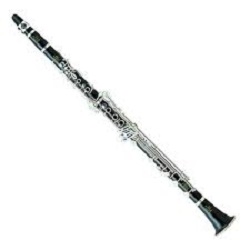
Used for classical music, the lesser-known basset clarinet in A can also reach a low C. It plays an important part in Mozart's compositions.
2. Basset Horn
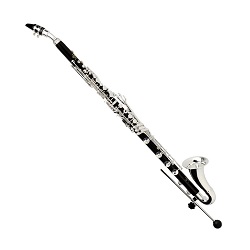
The basset horn in F is another of Mozart's favorite instruments and works well in classical music although it is rarely used now. Over the years it has changed from a curved to mostly straight design.
3. C Clarinet
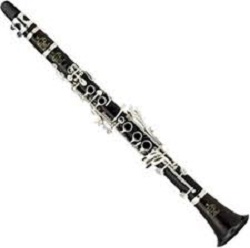
This instrument lost favor with clarinetists who preferred the B-flat clarinet. Also known as a soprano clarinet in C, it used to be very popular until composers turned towards instruments with a deeper sound.
4. D Clarinet
Sometimes called the sopranino clarinet in D, this instrument was once used in Stravinsky's composition The Rite of Spring. Although now, this particular clarinet isn't often played.5. Piccolo Clarinet
The A-flat piccolo clarinet has a very high pitch that exceeds even the E-flat clarinet. It is a very small clarinet. In fact, it only measures a little over a foot long.While once used in Italian military bands, it is now rare and mostly obsolete.
Octo-Contrabass and Octo-Contra-Alto
The octo-contrabass is the biggest and heaviest clarinet. It is one octave below a regular contrabass clarinet.The octo-contra-alto clarinet is smaller and its pitch is one octave lower than the normal contra-alto clarinet.
Considering the large size and extreme rarity of these two types of clarinets, it is unlikely you will ever see or hear one in person.
What the Clarinet Teaches Us About How Music Changes over Time
Clarinets are a recent addition to the musical instrument world. Some types of clarinets are rare and produce a very specific sound while others are versatile enough for almost any music.
From the B-flat clarinet to the experimental octo-contrabass, the clarinet has many uses and an impressive range.
Certain clarinets have gone out of style as music tastes have shifted, but some are gaining popularity once more. This tells us that the clarinet has definitely earned a spot in music of all kinds.
You can contact us or visit our location if you're thinking about picking up a clarinet for yourself. Bb clarinet is one of the best choices for beginners and young clarinet players.is a grenadilla wood model featuring silver plating and a cylindrical bore design that makes it easy to keep in tune.
The post A Musical Introduction to the Different Types of Clarinets first appeared on Merriam Pianos
2359 Bristol Cir #200, Oakville, ON L6H 6P8
(905) 829-2020
